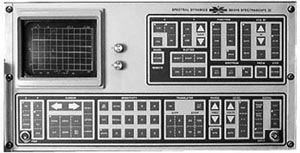last update: August 29, 2003
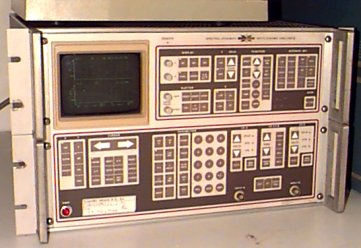
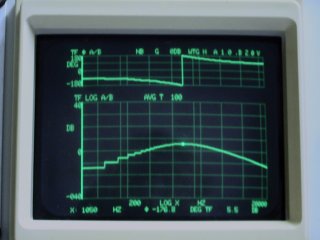 When designing grows to become more than producing go/no go results, sooner or later you want a spectrum analyzer. However,
a good spectrum analyzer costs tens of thousands of dollars. As a hobbyist, you don't really need the GHz range of machines
however (ok, maybe if you're a HAM). Being an audio enthusiast myself, I was looking for a baseband, reasonably high
resolution machine.
When designing grows to become more than producing go/no go results, sooner or later you want a spectrum analyzer. However,
a good spectrum analyzer costs tens of thousands of dollars. As a hobbyist, you don't really need the GHz range of machines
however (ok, maybe if you're a HAM). Being an audio enthusiast myself, I was looking for a baseband, reasonably high
resolution machine.
Nowadays, you can easily buy soundcard based solutions. They did not appeal to me for several reasons, usually the frequency range is not very high (even with 96 kHz sampling cards you don't get past 48 kHz), resolution is low and dependent on the entire computer configuration. Software on the other hand is very flexible and easy to use.
Then this SD375 came along. I was able to buy it for about $50. Considering it weighs around 60 kgs it weren't even bad value if I just got dead metal. But I got a lot more. 100 kHz by 70 dB of signal space (which gets better through digital filtering/ averaging routines). It works flawlessly and while it seems rocket science, after a while you notice that it's in fact very user friendly and easy to use. It normalizes its measurements so you'll always be sure that what you see is what you measure (I wouldn't know with PC software!). Manipulation and calibration of measurement data is possible, as is zooming in on parts of the spectrum. Sophisticated statistic and stochastic routines included. So, you get a reliable hardware platform with well-thought through software. An ideal combo.
The objective of this page is to provide a knowlegdge base about this machine and its relatives for those who find or have
one, so as to prevent them from being just thrown away (it's what nearly happened to mine) or just sit uselessly on a shelf.
More information will be added as I find the time...!
Please let me know when you find this page useful or have any SD equipment of your own. Would love some pictures and words about it.
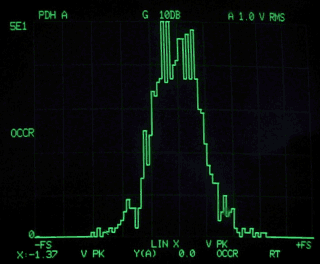
SD manuals
Thanks to Cognitive Vision, the SD manuals are available for download! Proceed to the 'downloads' page, then select
'legacy product Manuals and Guides'. These are the original and complete operator's manuals! Big thumbs up for Cognitive
Vision for making these available on-line.
PC interfacing
This is just so very cool! Co-SD375 owner Al Klappenberger and I have been toying around
with our SD375s and after many e-mails, lots of trial and error and several late-nighters we managed to interface the SD375
to a standard PC. Now you can transfer your measurements to any graphical format and include them into reports etc. This is
something I've been looking for for a very long time!
SD375 Brochure
This is actually quite an informative document, instead of the misleading sales brochures of today. After reading it carefully
a few (dozen) times, I figured out how to operate this beast without the users manual on hand. 20 pages, 9.1 MB pdf download.
The how and why of zoom
Brochure for the zoom option, explaining its working principle and the advantages involved (of course!).
Translator Option User's manual
User's manual for the zoom (digital translator) option.
The how and why of equalized transfer function and phase
Brochure telling you why you want a 2-channel analyzer with measurement correction data memory.
Text entry manual: (short version 25 kB | long version 196 kB)
You can enter overlay text on a plot, very handy when saving or printing plots. However, without this document you won't get
it done (25 kB pdf).
Detecting, enhancing or eliminating signals in noise (865 kB pdf)
How to push your analyzer to the limit and pull the signal you're looking for out of 20 dB noise - spectacular!
Digital I/O (option 3) instruction manual
kindly supplied by Cognitive Vision
Part 1
| Part 2
Signal genator (option 4) instruction manual
OCR'ed version!
Theoretical articles
Trigonometric Transforms 64 pages, 1.15 MB
Windows and Figures of Merit 21 pages, 300 kB
On Overlapped Fast Fourier Transforms 6 pages, 145 kB
Quick recap of all the math required to understand the workings of a signal analyzer. Well-written, high density material.
What windowing functions do to your data and how to determine validity and optimal window form.
A nifty way to achieve virtual higher sampling rates.
- The service manual (especially of the signal generator plug-in). I have volume 1 and am seeking volume 2. Costs of copying and shipping will be compensated for.
- Some, all or less of the accesories (will pay)
- Octave (option -3 and -4) plug-ins
- List of recognized mnemonics to communicate to PC via RS232 or HPIB
Spectral Dynamics home
No one will deny they still make fabulous analysis equipment. I'd certainly love to have such a system. But the build quality
of the 80s (not to forget weight...) is not economic anymore.
SD360
The direct predecessor of the SD375 was the SD360. Most of the controls are mechanical, hence the boasting about electronic
controls in the SD375 brochures. Here are some pictures from an eBay auction:
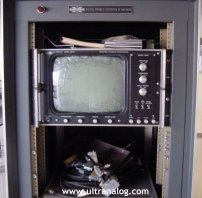
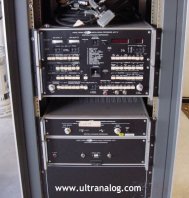
What an impressive machine! Comes with a 7 foot 19 inch rack. For the first time, I now know why the 375 is described as being "compact"...
SD340-35
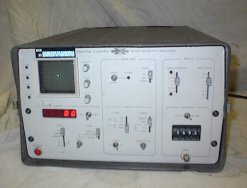
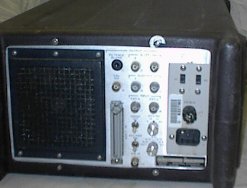
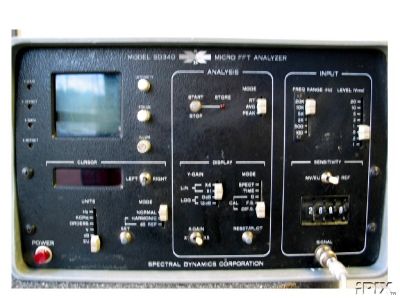
This spectrum analyzer covers 0-20,000 Hz. It is in excellent condition and works perfectly. I had a LOT of fun, playing with...er... testing it. It has three basic analysis modes, including Real Time, Average, and Peak. The Store button will freeze the display, in any of the three analysis modes. The on-screen cursor dot/line can be positioned anywhere on the screen. A six-position switch causes the value, at the cursor dot, of any of the following, to be displayed, on a 5-digit LED readout: Hz, KCPM, Orders, Volts, dB, or Engineering Units. There are also three Cursor Mode setting, including Normal, Harmonic, and dB REF, with a SET button associated with the last two. When switched to harmonic mode, bright dots appear at each harmonic of the current cursor frequency-position. The input Frequency Range has six settings, to control the frequencies spanned by the screen, including 100 Hz, 500 Hz, 2000 Hz, 4000 Hz, 10,000 Hz, and 20,000 Hz. Additionally, there is a X-Gain switch, with X1 and X5 settings. The Input Level for full vertical deflection can be set to any of eight Vrms values: 0.1 Vrms, 0.2, 0.5, 1, 2, 5, 10, and 20 Vrms. Additionally, there is a Y-Gain switch with settings of Linear X1 and Linear X4, and Log 0 dB and Log 12 dB. There is also an Input Sensitivity setting, switchable between MV/EU and dB Ref, with four digital (0-9 ea) thumbwheels. There is also an oscilloscope mode, which changes the display to the time domain, with horizontal sweep corresponding to the Freq Range setting and vertical deflection corresponding to the Input Level setting. This unit also has Intensity, Focus, and graticule Illumination knobs, as well as a Reset/Plot button. On the REAR PANEL, there are two rotary switches: one labeled AVG NO, with settings of 8, 16, 32, and 64, and another labeled with settings of OUT, A/A, A/V, A/D, V/V, V/D, and D/D. There are six BNC outputs, labeled Scope X and Y, Retrace Blank, Cal Sig, and Plotter X and Y. And there are three BNC inputs, labeled Sig In, Ext-X and Ext-Z. There are also two toggle switches labeled Sweep Int/Ext and Acc Pwr On/Off, and a 5A slow-blow fuse. This is a really nice spectrum analyzer, well-suited for both machine vibration analysis AND sound pressure (audio) analysis (the manual has examples for both). It is in an extremely-rugged black-plastic cabinet/housing.
SD345
Called SpectraScope III, this seems to be the SD375's little sibling. Picture from Toronto Surplus & Scientific Inc.
